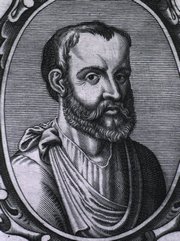|
The word sympathetic is the adjectival form of sympathy. This word arises from the Greek [συμπάθεια]and is composed of [syn/sym] meaning “together” and [pathos], a word which has been used to mean “disease”. In reality “pathos” has to do more with the “feeling of self”. Based on this, the word sympathy means “together in feeling”, which is what we use today.
How the term got to be used to denote a component of the so-called autonomic nervous system is part of the history of Medicine and Anatomy.
Galen of Pergamon (129AD-200AD), whose teachings on Medicine and Anatomy lasted as indisputable for almost 1,500 years, postulated that nerves were hollow and allowed for “animal spirits” to travel between organs and allowed the coordinated action of one with the other, in “sympathy” with one another. As the knowledge of the components of the nervous system grew, this concept of “sympathy” stayed, becoming a staple of early physiological theories on the action of the nervous system.
Jacobus Benignus Winslow (1669-1760) named three “sympathetic nerves” one of them was the facial nerve (the small sympathetic), the other the vagus nerve, which he called the “middle sympathetic”, and the last was what was known then as the “intercostalis nerve of Willis” or “large sympathetic", today’s sympathetic chain. Other nerves that worked coordinated with this “sympathetics” were considered to work in parallel with it. It is from this concept that the term “parasympathetic” arises.
|

Galen of Pergamon
(129AD - 200AD)
|
| Interestingly, the ganglia on the sympathetic chain were for years known as “small brains” and it was postulated that there was a separate multi-brain system coordinating the action of the thoracic and abdominopelvic viscera. The coordination between this “autonomous nervous system” and the rest of the body was made by way of the white and gray rami communicantes.
Today we know that there is only one brain and only one nervous system with an autonomic component which has a “sympathetic” component that is mostly in charge of the “fight or flight” reaction and a “parasympathetic” component that has a “slow down” or “depressor” function. Both work coordinated, so I guess Galen was not "off the mark" after all.
So, we still use the terms “sympathetic” and “parasympathetic”, but the origin of these terms has been blurred by history.
Sources:
1. "Claudius Galenus of Pergamum: Surgeon of Gladiators. Father of Experimental Physiology" Toledo-Pereyra, LH; Journal of Investigative Surgery, 15:299-301, 2002
2. "The Origin of Medical Terms" Skinner, HA 1970 Hafner Publishing Co.
3. "Medical Meanings:A Glossary of Word Origins" Haubrish, WS American College of Physicians Philadelphia, 1997
4. "The History of the Discovery of the Vegetative (Autonomic) Nervous System" Ackerknecht, EH Medical History, 1974 Vol 18.
Original image courtesy of Images from the History of Medicine at nih.gov
Note: The links to Google Translate include an icon that will allow you to hear the pronunciation of the word.
|



